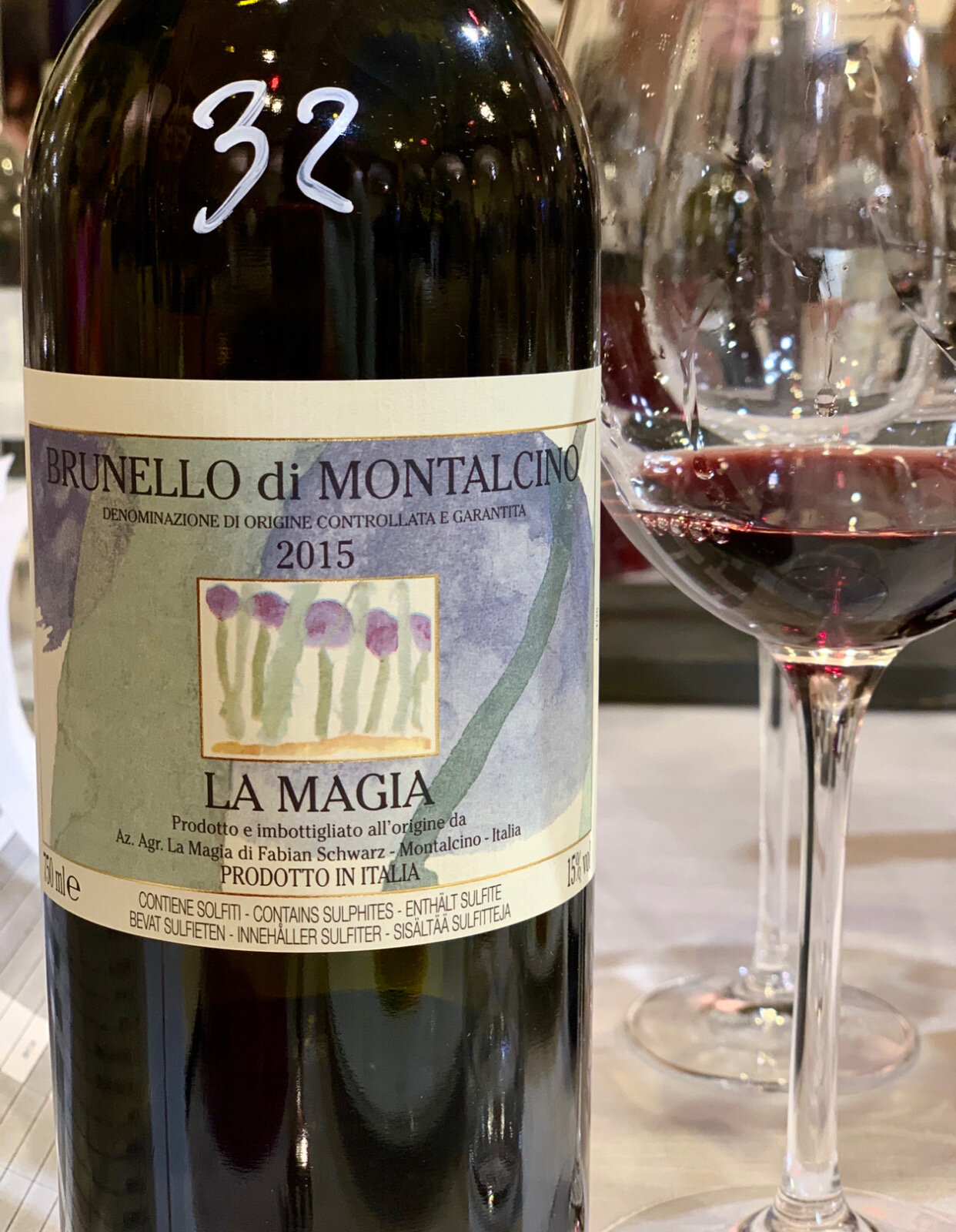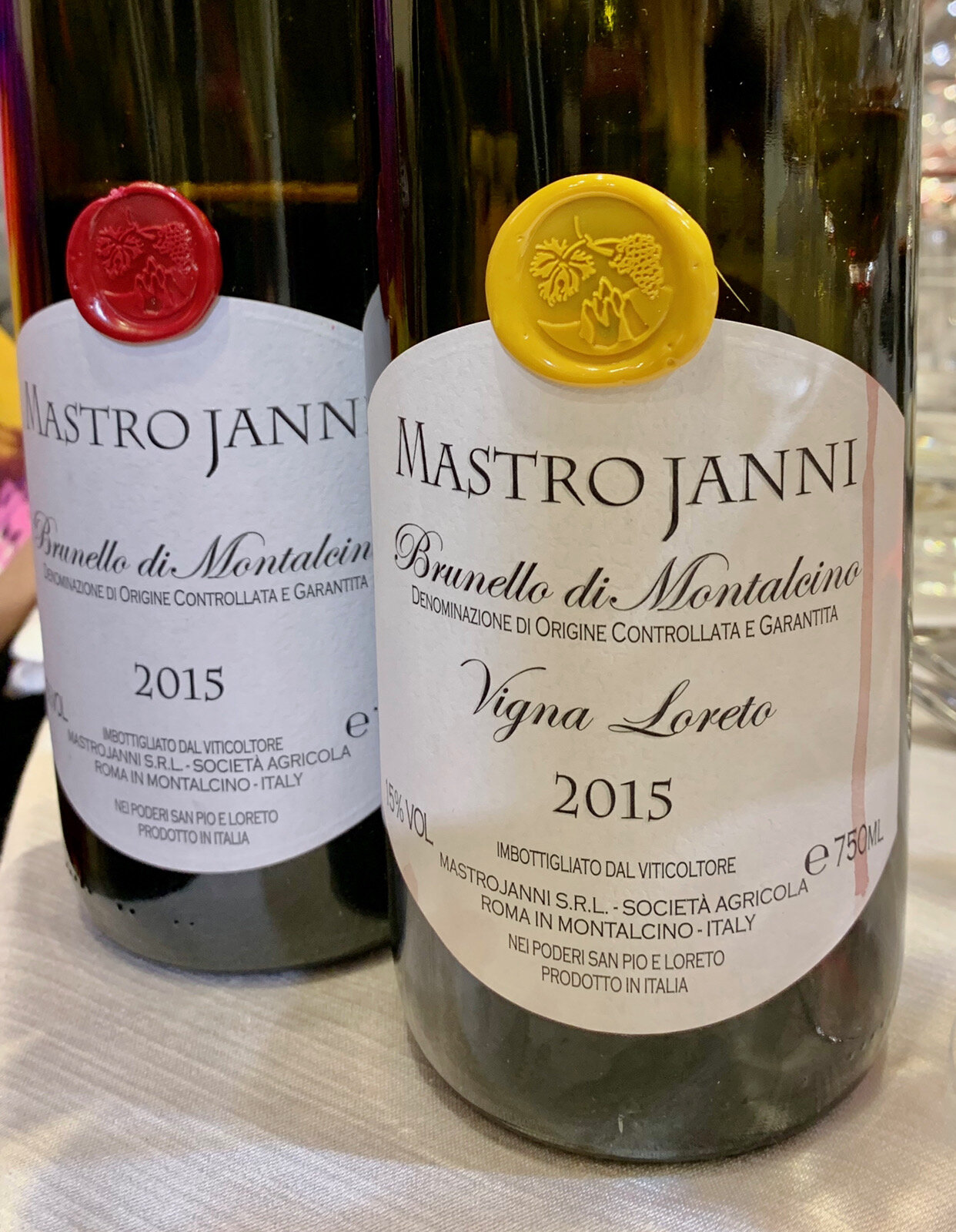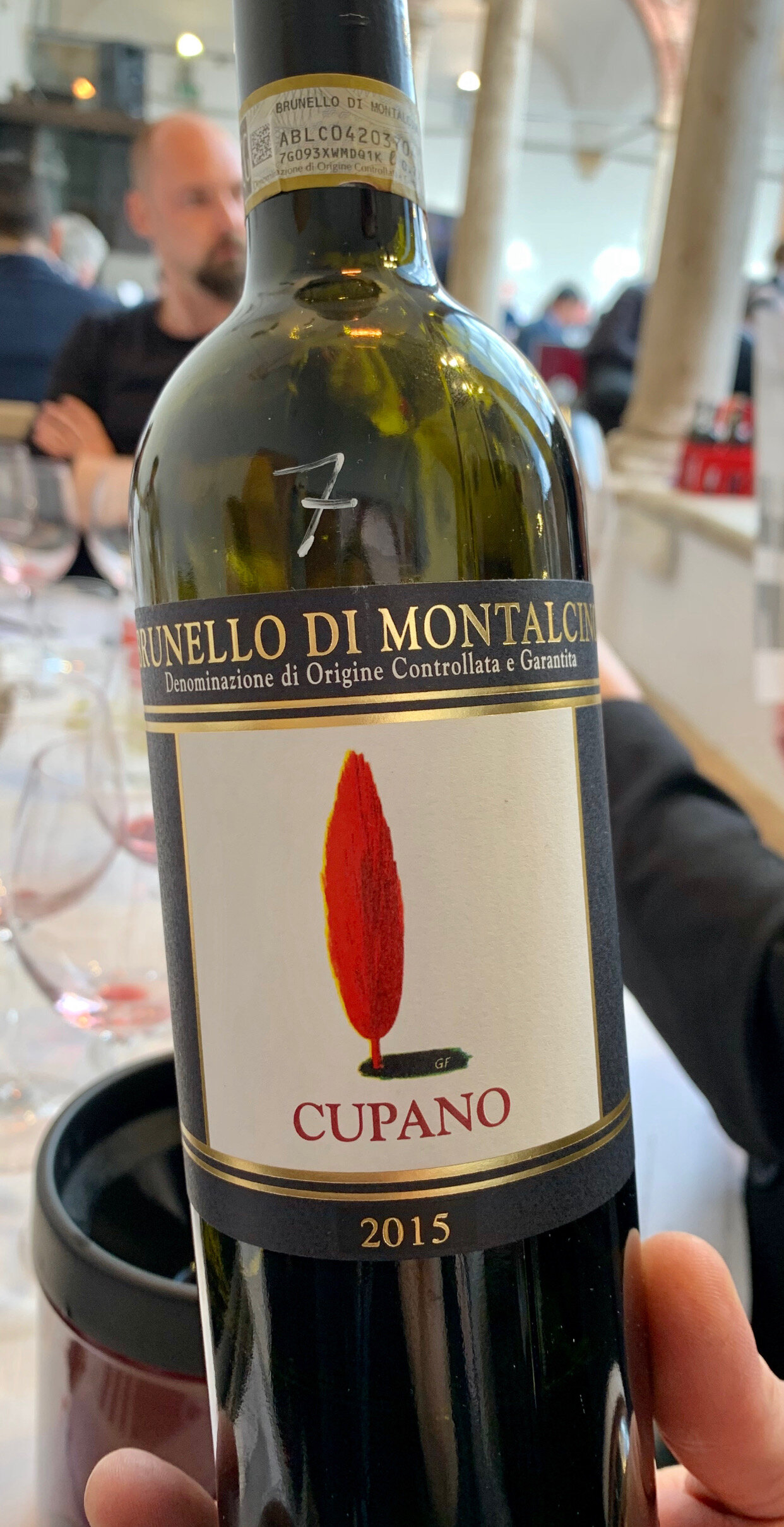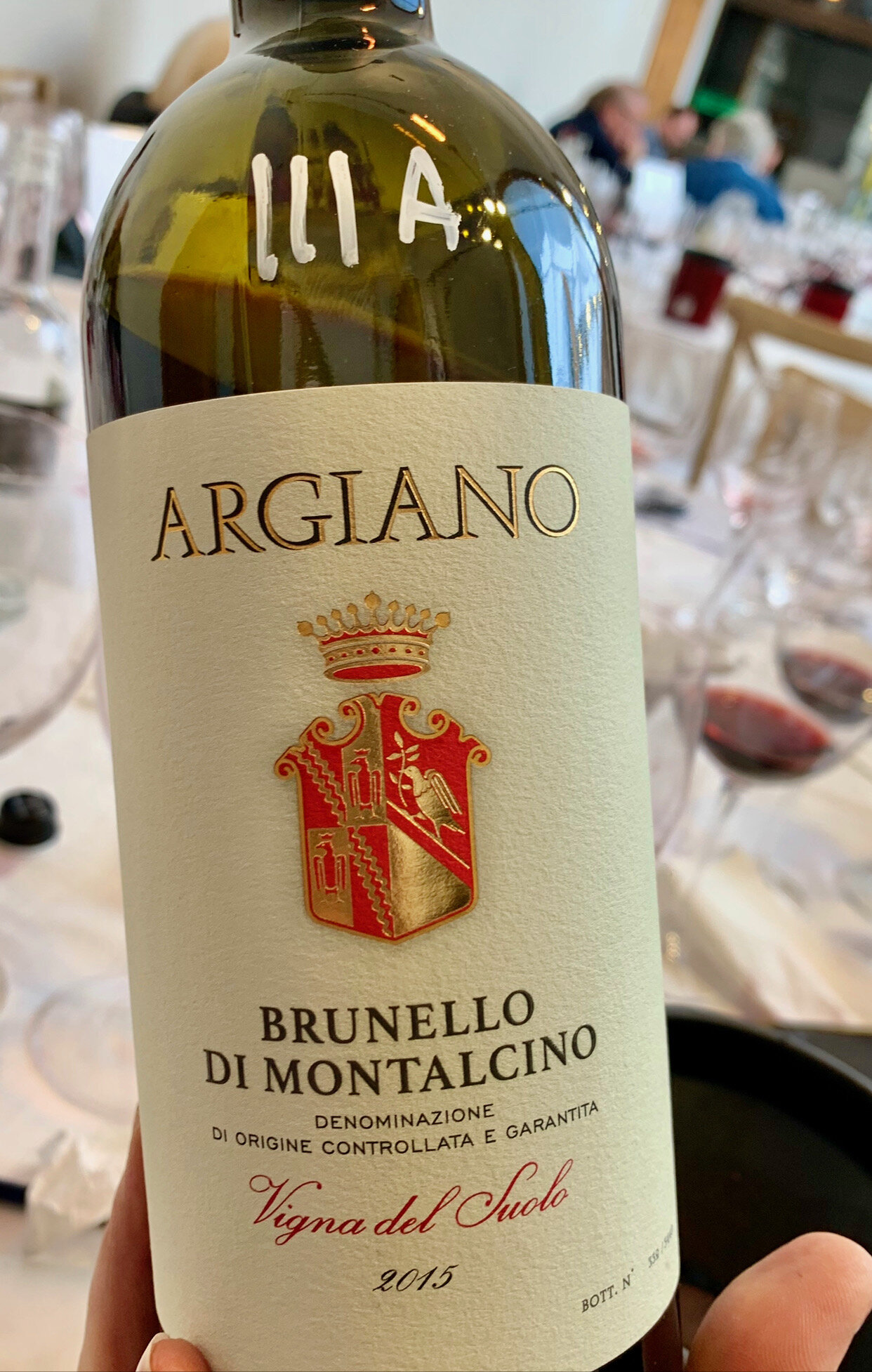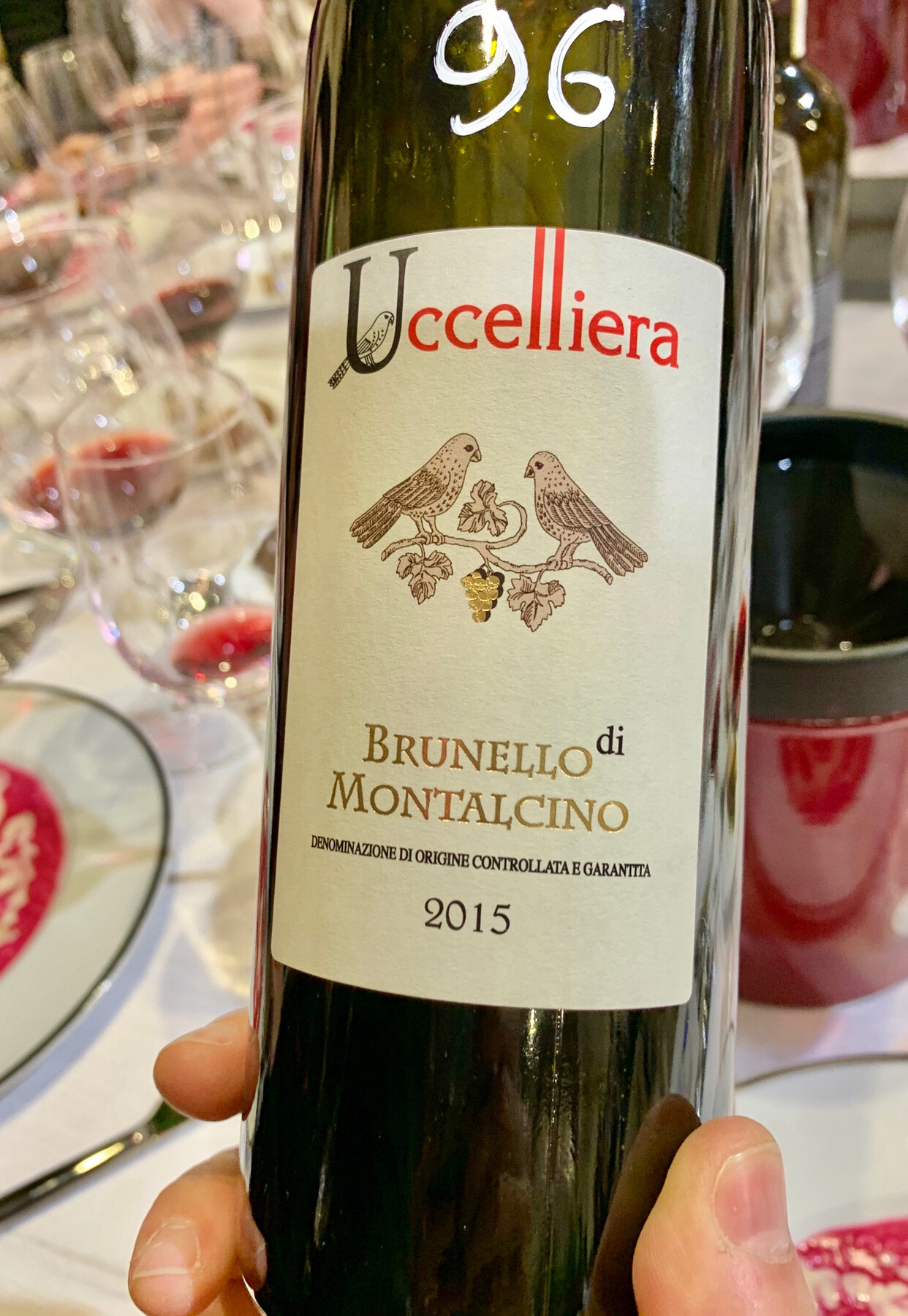The Fabulous '15s: Getting to Know Brunello di Montalcino
/“Close your eyes and imagine a small land, full of hills, far from everywhere — a sort of island — where slopes with different textures of soils have the protection of a volcanic mountain, and with wind from the sea, all together in a handful of kilometers, as a sort of gift from God.”
The town of Montalcino overlooks the hills below. All photos by Lisa Denning.
Montalcino is a walled medieval village in Tuscany, about a two-hours’ drive south of Florence. The town’s imposing 14th century fortezza (fortress) sits atop its highest point, offering spectacular views of the countryside below: rolling hills of grassy fields, evergreen forests, olive groves, and steep vineyards adjacent to ancient stone wine cellars. The area is home to one of Italy’s most famous and expensive wines, Brunello di Montalcino, the “little brown one of Montalcino.” The wine is made from a local clone of the Sangiovese grape that, true to its name, is small and dark brownish.
Although wine has been made here since the Etruscan age, Montalcino’s modern history of winemaking is relatively short. Brunello was mostly unknown outside of Italy until 1980 when it became one of four Italian wines to gain top quality DOCG (Denomination of Controlled and Guaranteed Origin) status. Since then, the number of wineries in Montalcino has grown from 53 to over 200. Today, Brunello is considered one of Italy’s most critically acclaimed wines, revered worldwide for its elegant expression of Sangiovese.
A Magic Bond Between Man and Nature
Montalcino’s hilly viticultural area is square-shaped and bounded by four rivers: Ombrone, Asso, Arbia, and Orcia. Here you will find a varied terroir that gives Brunello its distinct personality. “Montalcino has a unique microclimate,” says Fabian Schwarz, owner of La Magia winery, “influenced by both the sea and the mountain (Monte Amiata), and with altitudes that go from 200 up to 600 meters.”
The brisk winds coming off the sea, along with naturally cooler temperatures found in higher elevations, offer the vineyards much-needed cooling from Montalcino’s intense summertime sun. Schwarz also gives credit to the area’s many soil types — mostly composed of galestro (a crumbly marl), but also containing limestone, clay, schist, and volcanic soil — which, he says, “add a beautiful minerality to the wines.”
Many of the winemakers mentioned biodiversity as a factor that contributes to Brunello’s distinctiveness. Bernardino Sani, general manager of Argiano winery, told me that the area is one of the most well-preserved environments in the world for agriculture, with only ten percent of the land devoted to vineyards. “The rest is forest, fields, and olive trees, or used for honey and cereal production,” says Sani, “and mostly organically cultivated, with no industrial production in the area.”
The long-standing, strict vinification and production rules guaranteed by the Consortium Brunello di Montalcino also add to the wine’s singularity. Brunello is required to be a monovarietal wine, meaning made from one grape variety, in this case Sangiovese Grosso. “This has always been a key characteristic for the wines of Montalcino,” says Tomasso Cortonesi of Cortonesi La Mannella. “And it has been like this since the beginning.”
Furthermore, Brunello’s long aging requirement, five years before release to the market, is an important factor in its uniqueness. Sangiovese grapes are high in acidity and tannins, and the wine’s extended aging period allows for a harmonious melding and softening of these initially-harsh components. The best Brunellos are supple and elegant wines that remain drinkable for decades. They display a floral and herbal freshness, with hints of cherry fruit, earth, tar and leather notes — all supported by a strong, yet refined, structure.
In addition to Montalcino’s physical characteristics and unique winemaking methods, its history of self-reliance has ensured the high quality of the wines. Unlike other parts of Tuscany, as well as most of Italy, Montalcino’s wine culture was always based on quality, not quantity. “Montalcino maintained its independence for a long time in spite of it being an important point along Via Francigena, one of the main pilgrim routes of the past,” says Andrea Mantengoli. “From an anthropological point of view, the independence of the past saved Brunello from all the contaminants that, during the past several decades, have affected the other important Tuscan denominations.” High production vineyards and the making of mass quantities of wine have never been the norm in Montalcino.
2015, an Outstanding Vintage To Drink or Hold
In February, before the world went into lockdown, the Consortium hosted the annual Benvenuto Brunello (“Welcome Brunello”) event, a preview for select press and trade. The newly released 2015 Brunellos were tasted and evaluated over the course of three days.
Inside Benvenuto Brunello’s tasting for Media and trade
Word was already out that 2015 was an outstanding vintage, one of the best in recent decades — a warm and sunny growing season that yielded healthy, ripe fruit. Wine writer Ian D'Agata, author of Native Wine Grapes of Italy, wrote, on the wine website Vinous, that 2015 is “easily one of the top eight or ten vintages of all time.” He describes the wine as having a magical balance of fruit, structure, and alcohol. “Most of the 2015 Brunellos are characterized by suave, voluptuous mouthfeels, bordering on the opulent,” says D’Agata, “but with very good, juicy acidities that nicely lift and carry the velvety ripe flavors.”
Wine critic James Suckling was impressed by the wines’ beautiful depth of fruit and great structure, giving the 2015s unusually high accolades. “The seamless tannins seem to melt into the wine,” he says of the 2015s, “a characteristic I have never seen in my 36 years visiting the area.”
The weather in 2015
Many of the producers I spoke with talked about the changing weather patterns in Montalcino. During the past couple of decades, in addition to a warming trend, they are dealing with more extreme weather conditions, like drought, excessive rain, and violent winds. “In order to face this,” says Sani, “you need to be an expert viticulturist and your vines must be in perfect balance with the environment.” To achieve this equilibrium in the vineyards, many producers have converted to organic farming methods, eliminating the harmful environmental impact of pesticides and other chemicals.
The 2015 vintage in Montalcino was a bit of a climatic rollercoaster, with a notably cold and rainy winter and spring, which then gave way to a hot and dry summer. And while a warm growing season ensures fully ripe grapes, there is the risk of overripeness that comes with intense heat. Grapes that become too ripe produce wines with jam-like fruit flavors, too little acidity and high alcohol levels. Fortunately, beginning in mid-August, cool nights arrived which helped preserve the grapes’ balance of fruit, acidity, and alcohol. 2015’s tiny, thick-skinned berries contained a small amount of juice, perfect for making rich, approachable wines of great aromatic complexity and fine-grained tannins. “You need a spoon to have these wines,” jokes Elisabetta Mantengoli of La Serena.
Drink or Hold?
Elena Pellagrini of Cerbaia noted that in 2015 it took very little effort to produce high quality grapes of vibrant color and ideal ripeness. “For sure,” she says, “we’re going to remember this harvest forever.” While Pellagrini says her wines are “perfect” to drink now, she recommends waiting until 2025, since her wine becomes better with the years.
Count Francesco Marone Cinzano, owner of Col d’Orcia told me that 2015 reminds him of the great 1997, an approachable-when-young vintage. He calls the 2015s a “great expression of the weather patterns of recent years.” As for drinking the wine, Cinzano says they can be enjoyed now, “provided you open and decant them in advance.” But all the producers agreed that the refinement of Brunello comes with time in the bottle. “The 2015s will age very well,” says Cinzano, “and in the case of Col d’Orcia, as usual, the wine will reach full maturity in 20 to 25 years time.”
The question is, can you wait that long? I suggest buying a case or two of 2015s to drink over the course of a decade or two. This way, you can see for yourself how each year in the bottle changes and enhances the wine. Cellaring these delicious wines requires much discipline, but it will yield the greatest of rewards.
Recommended 2015 Brunello Wines:
During late 2019 and early 2020, I attended tastings of the newly released Brunellos at events in Montalcino and New York City. I was able to revisit (and be awed by) long-time favorites including Il Poggione, Sassetti Livio Pertimali, Altesino, and Uccelliera. But, I also discovered a few new-to-me producers that were showing outstanding wines, like Salvioni, La Magia, Cupano, Col d’Orcia, La Serena, and Castello Romitorio.
Alessandro Bindocci of Il Poggione, long considered one of the best wineries of Montalcino.
Giulio and Mirella Salvioni holding their coveted, small-production wine made from La Cerbaiola vineyard, one of the top plots for vines in Montalcino.
While far from comprehensive (due to the abundance of great producers in Montalcino), below are several other wineries whose 2015 Brunellos are worth seeking out.
Argiano, Banfi, Barbi, Biondi-Santi, Camigliano, Campogiovanni, Canalicchio di Sopra, Caparzo, Carpineto, Casa Raia, Casanova di Neri, Casisano, Cerbaia, Ciacci Piccolomini D’Aragona, Corte Pavoni, Cortonesi, Gianni Brunelli Le Chiese di Sotto, Greppone Mazzi Ruffino, Il Marroneto, La Fiorita, La Gerla, La Magia, Lazzaretti, Le Chiuse, Máté, Mocali, Pian delle Querci, Poggio Antico, Poggio San Giorgio, San Polo, Talenti, Tenute Silvio Nardi, and Voliero.









